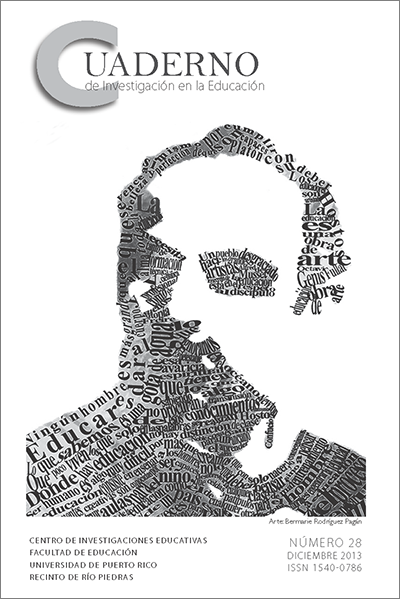Résumé
El propósito de esta investigación con niños es darles voz a cinco preescolares que viven en Puerto Rico, con el fin de descubrir qué significa, para ellos, jugar y cómo juegan en su ambiente educativo. El trabajo se fundamenta en la visión posmodernista del niño y en la nueva sociología de la niñez. El estudio de caso múltiple facilitó conocer los puntos de vista de los participantes. Los niños dirigieron el estudio a través de los retratos que tomaron y las conversaciones que desarrollaron durante una visita guiada, al observar sus fotos en la computadora y en un libro, y al dibujar su área favorita. Mediante las conversaciones, se descubre que, para ellos, jugar en el salón implica participar en un proceso social que les brinda una fuente de posibilidades, al involucrarse en un acto creativo y reflexivo que les facilita la construcción de conocimiento.
Cómo citar:
Torrech-San Inocencio, L. A. (2013). "¿Pero tú no ves que estoy en la playa surfeando?" Las voces de cinco niños preescolares de Puerto Rico en torno a su visión del juego en el ambiente educativo. Cuaderno de Investigación en la Educación, 28, 13-35. Recuperado a partir de https://revistas.upr.edu/index.php/educacion/article/view/13570
Références
Alderson, P. (2008). Children as research: Participation rights and research methods. En P. Christensen & A. James (Eds.), Research with children: Perspectives and practices (2da. ed., pp. 276-290). New York, NY: Routledge.
Bae, B. (2010). Realizing children‘s right to participation in early childhood settings: Some critical issues in Norwegian context. Early Years, 30(3), 205-218.
Brodova, E. (2008). Make-believe play versus academic skills: A Vygotskian approach to today‘s dilemma of early childhood education. European Early Childhood Education Research Journal, 16(3), 357-369.
Cheng, M. & Johnson, J. E. (2010). Research on children‘s play: Analysis of developmental and early education journals from 2005 to 2007. Early Childhood Education Journal 37, 249-259.
Christensen, P. & James, A. (2008). Childhood diversity and commonality: Some methodological insights. En P. Christensen & A. James (Eds.), Perspectives and practices (2da. ed., pp. 156-172). New York, NY: Routledge.
Clark, A. & Moss, P. (2005). Listening to young children. The mosaic approach. Londres: National Children‘s Bureau.
Clark, B. (1997). Growing up gifted (5ta ed.). NJ: Prentice Hall.
Copple, C. & Bredekamp, S. (2009). Developmentally appropriate practice in early childhood programs serving children from birth through age 8 (3ra. ed.). Washington DC: NAEYC.
Dahlberg, G., Moss, P. & Pence, A. (2007). Beyond quality in early childhood education and care: Languages of Evaluation (2da. ed.). New York, NY: Routledge.
Einarsdottir, J. (2005). Playschool in pictures: Children‘s photographs as research method. Early Child Development and Care, 175(6), 523-541.
Einarsdottir, J., Dockett, S. & Perry, B. (2009). Making meaning: Children‘s perspectives expressed through drawings. Early Child Development and Care, 179(2), 217-232.
Formosinho, J. & Barros Araújo, S. (2006). Listening to children as a way to reconstruct knowledge about children: Some methodological implications. European Early Childhood Education Research Journal, 14(1), 21-31.
Harcourt, D. & Einarsdottir, J. (2011). Introducing children‘s perspectives and participation in research. European Early Childhood Education Research Journals, 19(3), 301-307.
Hendrick, H. (2008). The child as a social actor in historical sources: Problems of identification and interpretation. En P. Christensen & A. James. (Eds.), Research with children: Perspectives and practices (2da. ed., pp. 40-65). New York, NY: Routledge.
Hostos, E. M. (1969). Obras completas, XIII. San Juan, PR: Edición Conmemorativa del Gobierno de Puerto Rico.
Izumi-Taylor, S., Pramling Samuelsson, I. & Rogers, S. C. (2010). Perspectivas hacia el juego en tres naciones. Estudio comparativo entre Japón, los Estados Unidos y Suecia. Early Childhood Research and Practice, 12(1), 1-14. Recuperado de http://ecrp.uiuc.edu
Marks-Tarlow, T. (2010). The fractal self at play. American Journal of Play, 3(1), 31-62.
Mayall, B. (2002). Towards sociology for childhood: Thinking from children‘s lives. Buckingham, UK: Open University Press.
Mayall, B. (2008). Conversations with children: Working with generational issues. En P. Christensen & A. James. (Eds.), Research with children: Perspectives and practices (2da. ed., pp. 109-124). New York, NY: Routledge.
Merriam, S. B. (1998). Qualitative research and case study applications in education. San Francisco, CA: Jossey-Bass.
Newton, E. & Jenvey, V. (2011). Play and theory of mind: Associations with social competence in young children. Early Child Development and Care, 181(6), 761-773.
Pascal, C. & Bertram, T. (2009). Listening to young citizens: The struggle to make real a participatory paradigm in research with young children. European Early Childhood Education Research Journal, 17(2), 249-262.
Pramling Samuelsson, I. & Johansson, E. (2006). Play and learning - inseparable dimensions in preschool practice. Early Child Development and Care, 176(1), 47-65.
Prout, A. y James, A. (2002). A new paradigm for the sociology of childhood? Provenance, promise and problems. En A. James & A. Prout (Eds.), Constructing and reconstructing childhood (2da. ed., pp. 7-32). Londres: Falmer Press.
Rogers, S. & Evans, J. (2006). Playing the game? Exploring role play from the children‘s perspectives. European Early Childhood Education Research Journal, 14(1), 43-55.
Sandberg, A. & Heden, R. (2011). Play‘s importance in school. Education 3-13: International Journal of Primary, Elementary and Early Years Education, 39(3), 317-329.
Stephenson, A. (2009). Horses in the sandpit: Photography, prolonged involvement and "stepping back" as strategies for listening to children‘s voices. Early Child Development and Care, 179(2), 131-141.
Vickerius, M. & Sandberg, A. (2006). The significance of play and the environment around play. Early Child Development and Care, 176 (2), 207-217.
Vygotski, L. (1987). Pensamiento y lenguaje. Argentina: Editorial La Pléyade.
Wolcott, H. (1994). Transforming qualitative data. Description, analysis, and interpretation. London: Sage.
Woodhead, M. (2002). Psychology and cultural construction of children‘s needs. En A. James & A. Prout (Eds.), Constructing and reconstructing childhood (2da. ed., pp. 63-84). Londres: Falmer.
Yin, R. K. (2003). Case study research: Design and methods (2da. ed.). Thousand Oaks, CA: Sage.

Ce travail est disponible sous licence Creative Commons Attribution - Pas d’Utilisation Commerciale 4.0 International.
© Cuaderno de Investigación en la Educación 2013

